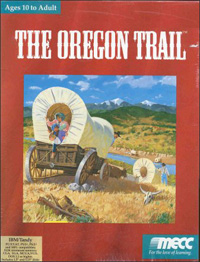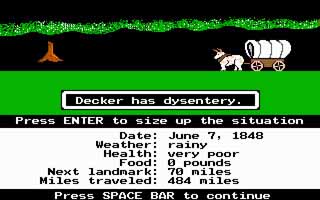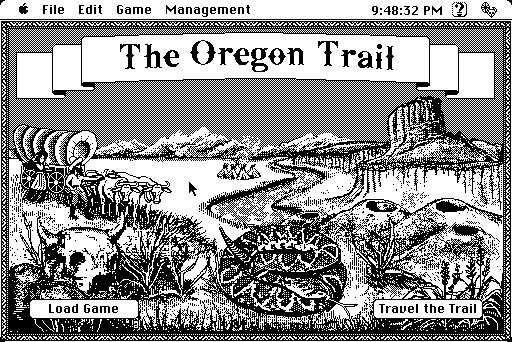MECC was for many years one of the major producers of educational content including courseware, videos, and educational computer games for the Apple II, Radio Shack, IBM PC, and later the Macintosh and Windows. MECC was instrumental in ensuring the US was ahead and invested sufficiently in educational computing.
 MECC was best known for The Oregon Trail, an early educational game based on the historic migration route used by pioneers to settle new parts of the United States during the 19th century. The organization later introduced other titles including Amazon Trail, Lemonade Stand, Odell Down Under, Number Munchers, and Dinopark Tycoon.
MECC was best known for The Oregon Trail, an early educational game based on the historic migration route used by pioneers to settle new parts of the United States during the 19th century. The organization later introduced other titles including Amazon Trail, Lemonade Stand, Odell Down Under, Number Munchers, and Dinopark Tycoon.
Prehistory
Before MECC was formed, the use of computers in education was limited primarily because it was too expensive for the majority of institutions. One of the first generalized computer assisted instruction systems was PLATO, which was developed at the University of Illinois in 1960 by Donald Bitzer.1 Although PLATO was a financial failure, it pioneered many concepts, such as the many means of communication like email and message boards.
Throughout the 1970s and ’80s, many popular games were developed on the PLATO system like Avatar, Empire, Airfight, Freecell, and several “dungeons and dragons” games. PLATO was rapidly improved as the decades passed by, each time enhancing its capabilities and allowing more students to use it at once through terminals.
 By 1970, 720 hours worth of courseware had been developed for PLATO III covering many different levels of education.2 During the ’60s, William Norris (founder and CEO of IBM-rival Control Data Corporation) had provided Bitzer’s research group with CDC equipment. PLATO itself was originally developed using an Illiac-1, and later a CDC-1604 driving graphics terminals.
By 1970, 720 hours worth of courseware had been developed for PLATO III covering many different levels of education.2 During the ’60s, William Norris (founder and CEO of IBM-rival Control Data Corporation) had provided Bitzer’s research group with CDC equipment. PLATO itself was originally developed using an Illiac-1, and later a CDC-1604 driving graphics terminals.
Over time, CDC took a larger role in the completion of PLATO for the commercial market. CDC eventually acquired the rights for PLATO in 1976, and the final version was released in 1972. Despite the years of effort and financial backing (CDC invested more than $600 million into PLATO by 19803) from CDC, the system was unpopular because of its high cost. However, CDC showed no sign of giving up, as it launched an advertising campaign on the radio and in print, only to see it fail and backfire. After Norris left CDC in 1986, his successor Lawrence Perlman sold the PLATO division.4
The ’60s and ’70s proved to be the dawn of educational computing as many other projects were started. In Delaware, Project Delta introduced many high school students to computing. By 1976, 30 schools and 10,000 students were being served by Delta.
MECC Is Born
![]() Minnesota’s need for a state-wide educational computing plan was recognized by a committee under the Commissioner of Administration in the early 1970s.5 The MECC (Minnesota Educational Computing Consortium) was formed in 1973 with legislative support.
Minnesota’s need for a state-wide educational computing plan was recognized by a committee under the Commissioner of Administration in the early 1970s.5 The MECC (Minnesota Educational Computing Consortium) was formed in 1973 with legislative support.
It was ideal for MECC to be founded in Minnesota, as the state boasted a history in computing and was a center of technology after World War II. Control Data Corporation, Cray Research, and General Mills Electronic Group were founded in Minnesota, as well as many smaller supercomputer and technology firms. Their first products were instructional systems for mainframes. MECC began building a library accessed by educational institutions state-wide through computer terminals.
MECC introduced their first game, Oregon, in 1974. It was accessible through the MECC Timeshare system library and was entirely text based. Oregon was originally developed in 1971 by Don Rawitsch and two other college students (Paul Dillenberger and Bill Heinemann) at Carleton College in Minnesota.6 The first Oregon Trail was developed using a teletype and mainframe computer; it lacked sound and graphics. It was simultaneously used by 16 students on separate terminals.7 In 1974, Rawitsch joined MECC and installed Oregon onto the statewide computer system. Since all schools with computers in Minnesota were capable of accessing the system, soon the game was being widely used across the state by children of many ages.
The Commodore PET and Apple II personal computers were introduced in 1977; these two microcomputers are widely credited with starting the personal computing revolution. MECC transferred their most popular titles from the timeshare library to diskette for usage on the Apple II.
The Apple II soon became the computer of choice for schools across the United States after the state microcomputer bid was awarded to Apple Computer in September 1978 for its efforts in producing a complete, fully-featured, and affordable computer system with BASIC, assembler languages, and communications capabilities.8 This resulted in more than 10,000 Apple computers being distributed to Minnesota educational institutions.9 Apple also ran a program in California to donate thousands of Apple IIs to schools.
From Non-profit to Public Company
By the end of the 1970s, MECC was making a large impact, although it was still a very small organization with only 75 full-time employees.10 However, at this time competition was looming on the horizon as both Brøderbund Software and The Learning Company (TLC) were founded in 1980. Later TLC would play a large role in the educational computing industry and, more critically, would eventually jeopardize MECC.
 A graphics version of The Oregon Trail was released in 1979 to take advantage of the Apple II’s unique color capabilities, as the title continued to sell in quantity and sustain its popularity.11
A graphics version of The Oregon Trail was released in 1979 to take advantage of the Apple II’s unique color capabilities, as the title continued to sell in quantity and sustain its popularity.11
In 1984, MECC was renamed to Minnesota Educational Computing Corporation and reorganized to become a public corporation owned by the State of Minnesota. At the time, the organization had revenues of $4.9 million.
MECC’s first major project was an interactive video system called ‘Introduction to Economics’.12 In addition to its games titles, the MECC library also included computer software for English and Math including Processing Words and Writing a Narrative for the Apple II, and Elementary Math Logic for the Commodore 64.
The success of The Oregon Trail was so widespread that in 1985 MECC decided to distribute and sell the game across the country at a price of $29.95 to fund their educational efforts in Minnesota. However, MECC did not sell licenses. It sold the right to make copies of the MECC product, known as site-licensing in the software industry.13
By May 1985 over 5,000 school districts in the US were using MECC software on microcomputers. Minnesota school districts could get access to MECC’s entire software library (consisting of over 300 titles) for $450 a year, whilst out-of-state school districts paid $1,500. 14
Throughout the 1980s, key individuals from Apple Computer attended MECC conferences as keynote speakers including Apple co-founder and then-chairman Steve Jobs and Alan Kay (an Apple fellow) in 1982, Flord Kvamme (Executive VP of Sales at Apple) in 1983 and in 1985 John Sculley, then-CEO of Apple.15
In 1984, Apple introduced the Macintosh, which was the first commercially successful personal computer to use a graphical user interface. The Macintosh’s graphics capabilities were far ahead of their time, despite being black and white only. MECC ported its most successful titles to the Macintosh to take advantage of its graphics capabilities.
In 1989, Apple donated $2 million worth of computers to 23 schools to help children; Apple had done this before with the Apple II.16 Number Munchers and Word Munchers were the first MECC products to be available for all three major platforms in 1990 – the Apple II, Macintosh, and MS-DOS.
On May 4th, Apple Computer stated they were “firmly committed to the Apple II’s in the ’90s.” However only three years later, the last Apple II line of computers was discontinued. Despite this unexpected end to an incredible era, MECC continued to introduce new products for the Apple II. In 1993, 75% of computers in K-8 member districts were Apple IIs.17
Acquisitions and Closure
In May 1996, MECC was sold to SoftKey, and in October the company was re-named to The Learning Company (TLC); the deal was worth $250 million.
Many products in development were canceled in 1997. During 1997 and 1998, TLC spent the majority of its time not releasing new products but instead acquiring and purchasing the competition. The acquisitions included Creative Wonders from Electronic Arts, MindScape, Brøderbund, Software, Virtual Makeovers, and Palladium Interactive.
A year later the company’s older Minnesota offices were closed. Today, The Learning Company still exists, and The Oregon Trail is still sold. However, MECC’s other titles did not survive. TLC is an affiliate of Brøderbund and a subsidiary of Riverdeep, Inc.
Although its efforts are largely forgotten today, MECC was perhaps one of the most influential and important organizations in the field of educational computing ever. It was also more successful and had a much larger impact than earlier projects and initiatives to improve education and increase the awareness of computers in education.
Footnotes
- Interview with Donald Bitzer conducted by M. Price, 17 August 1982 (CBI: OH 283): 5 and 7.
- The PLATO System (Computer-based Education Research Laboratory, 1979)
- “CDC Introduces Stand-Alone PLATO,” Electronic News, October 20. 1980
- Joe Blade, “CDC will sell PLATO education system,” Star Tribune, July 19. 198.
- “MECC Timeline – The Seventies.” [Available Online] MECC Alumni; Available from http://www.geocities.com/meccalumni/Timeline7.html
- “The Oregon Trail.” [Available Online] Standard University [cited 1999]; Available from http://ldt.stanford.edu/ldt1999/Students/kemery/esc/otDesFrame.htm
- Ibid
- “MECC Timeline – The Seventies.” [Available Online] MECC Alumni; Available from http://www.geocities.com/meccalumni/Timeline7.html
- K. Brumbaugh, “Reflections on educational computing,” Creative Computing, Nov. 1984, pp170.
- “MECC Timeline – The Seventies.” [Available Online] MECC Alumni; Available from http://www.geocities.com/meccalumni/Timeline7.html
- “The Oregon Trail.” [Available Online] Standard University [cited 1999]; Available from http://ldt.stanford.edu/ldt1999/Students/kemery/esc/otDesFrame.htm
- “MECC Faces State Reorganization; Takes Plunge into Interactive Video,” Software Publishing Report, April 18. 1984, pp4-5.
- Lee Schafer, “A businessman among the bureaucrats. (Dale LaFrenz),” Corporate Report-Minnesota, Feb. 1989, pp90.
- Kendall J. Wills, “What’s new with non-profit organizations,” [Available Online] New York Times [cited May 5. 1985]; Available from http://select.nytimes.com/search/restricted/article?res=F40A1EFC3C5F0C768CDDAC0894DD484D81
- “MECC Timeline – 1980-1983.” [Available Online] MECC Alumni; Available from http://www.geocities.com/meccalumni/Timeline803.html
- “Apple II History.” [Japanese] http://www.apple2world.jp/apple2/HIS/HIS.html
- “MECC Timeline – 1993-1996.” [Available Online] MECC Alumni; Available from http://www.geocities.com/meccalumni/Timeline803.html
Keywords: #mecc
Short link: http://goo.gl/wS1uz0
searchword: mecc


